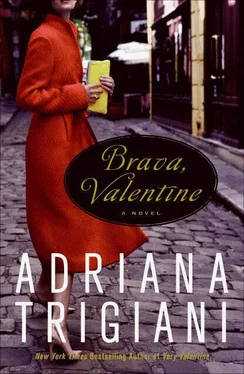“Let me call my mother to let her know.”
Roberta goes into her office to place the call. I take out my cell to call the hotel. The hotel room phone rings and rings. I imagine Gianluca went out exploring. The phone rings through to the operator. I leave a message that my plans have changed-I’ll be home for an early supper instead. Then I instruct the operator to leave a hard copy of the message under the door. I don’t want to take the chance that Gianluca will miss the message.
“Let’s go,” Roberta says. “Do you mind walking?”
“Not at all.”
“We live very close.”
As we walk to Roberta’s home, she tells me about her neighborhood. La Boca is known as the Greenwich Village of Buenos Aires. There are many similarities; there’s a meatpacking district, a series of small antique shops nestled among clubs and restaurants, and a thriving subculture of businesses that make handcrafted items-like Angelini Shoes. But the detail that gets to me, that says home to me in a way nothing else can or ever will, is the cobblestone streets of La Boca. I stop and take a picture on my cell. I send it to Gabriel’s phone. Just like Jane and Perry and Charles, Avalos and Olavarría and Suárez streets are paved with old, glorious, and bumpy cobblestones.
Roberta unlocks the gate, which opens into a complex of Mediterranean-style homes that face a common park. This is another small village within the village, off the busy Caminito Street.
The homes are surrounded by a privacy wall covered with waxy green vines. There is an old fountain in the center of the complex, its marble grooves worn smooth from weather and time. At the far end, in the midst of all this antiquity, is a plastic jungle gym for kids.
Roberta points to her home, a town house with a clay roof. The stucco is painted white, and the small entry porch is covered in multicolored tiles. Roberta opens the door and invites me in.
The furniture is cozy, childproof white-muslin-covered sofas and chairs, comfortable and washable. Antique chests made of hammered silver are tucked in corners. The walls are filled with paintings in an amalgam of styles, floating impressionism set amid realistic sketches done in charcoal and still-life renderings in watercolor.
Over the mantel is a whimsical oil painting of a theater tableau, a woman singing, surrounded by a chorus of peasants. I go to the mantel and look up to get a closer view. The signature in the corner is Rafael Angelini, the same man who drew the sketch that I found at home.
“My great-grandfather’s painting,” she says.
“He was very good.”
“I love it because he painted it,” she says.
An older woman brings the baby to Roberta and places him in her arms. “This is Enzo. My son. And this is my mother, Lupe.”
Lupe is around my mother’s age, small in build like Roberta, with black eyes and a deeper hue to her complexion. She embraces me.
“I am so happy to meet you,” I tell her.
“Thank you for agreeing to meet me,” Lupe says.
Lupe shows me to the veranda beyond the kitchen. The words my cousins choose are very telling. Agreeing to meet , peace , these little phrases must add up to something. It’s almost as if their words are preemptive, either to avoid an argument or to start one.
Lupe has set a beautiful table under a shady elm tree. The navy blue ceramic dishes pop against an apple green tablecloth. The center of the table has a lazy Susan, with a clay pot in the center, surrounded by strips of thin bread, called fainá, long, slim wedges of yellow and red peppers, a bowl of olives, and fronds of fresh green lettuce.
Lupe invites us to sit, while Roberta pours our glasses full of fresh lemonade made with honey. Lupe takes the baby from Roberta’s arms. “Time for Enzo’s nap.” She takes the baby in her arms and goes.
Roberta takes the lid off the clay pot. She picks up my dish, ladles a fragrant stew of meat and vegetables called estofado on the center of the plate, surrounds it with the fresh vegetables and the bread. She follows suit with her mother’s plate and then her own. Roberta sits and shows me how to eat the stew, scooping up the meat with the vegetables.
“I’m in awe of your factory,” I tell her. “The workforce…”
“Most of them have been there for many years.”
“I could tell. So quick, so professional. And the machines, the cutting room. What an operation.”
“I just took over for my father after he died and I do exactly what he would do. That’s all.”
“It’s impressive.”
“It’s a lot now, with the baby,” she admits.
“Do you have other children?”
She smiles. “A daughter. Ines is eighteen, and in university. I’m forty-four. Enzo was a surprise.”
I can’t imagine how Roberta runs a factory and takes care of a newborn baby. Of course, she has Lupe, and that’s a big help. My mother made it clear before my sisters and brother had children that she wanted to spend lots of time with the kids, but we were not to consider her a nanny. Lupe lives here with Roberta’s family, but even with the workload, she seems very happy.
I’m so tired at the end of a day, I can’t imagine having to take care of a husband and children. Tess and Charlie have figured out a schedule with the girls and Jaclyn, who works in an insurance office, runs to day care at lunchtime to see the baby with Tom. Mackenzie, who doesn’t have a job outside her home, keeps plenty busy chronicling the life she creates for Bret and their family with invitations, scrapbooks, and homespun projects like taking classes in organic gardening. Roberta’s life seems more like my own, or at least how my life would be if I had a family.
“What does your husband do?”
“My husband is an artist. I brought him home twenty-two years ago. And Mama said, ‘No artist!’ Because we come from a family of them, all dreamers. But finally, my mother said okay.”
“And now, a whole new chapter with a new baby. Enzo has lots of cousins to play with in New York.” I decide to broach the topic we’ve both been avoiding. “The whole family would love to meet you. Whatever happened in the past, Roberta, is the past. We should move forward from here-I hope we can.”
Roberta’s expression softens, so I continue. “Can you tell me what happened with Rafael and Michel?”
“I suppose I will have to tell you if we are to move forward,” Roberta says. “What do you know about Rafael?”
“All I know is I found a sketch in an old calendar. And then, what you’ve told me. If you don’t mind, let’s start at the beginning. Why did Rafael come to Buenos Aires?”
“He had to.”
“Was it about money?”
“No, no. Not at first. My great-grandfather’s goal was to stay in New York and work there, side by side with his brother. But then Rafael fell in love with my great-grandmother, Lucretzia.”
Roberta looks down at her hands. Her tapered fingers are lovely, but they are working hands with short nails and a thin gold wedding band. She wears no ornamentation beyond the ring.
“She was black. Michel did not support the union.”
“Because of her color?” I ask.
She nods.
I try to imagine New York City through the eyes of Rafael and Michel. Boundaries were clearly drawn. Italians did not venture above 14th Street except to make deliveries or to do building and maintenance work for hire. Immigrants laid claim to particular blocks and tenements, careful to carve out a place in the city where they could speak in their native language. But the barriers of race trumped religion and nationality. An Italian immigrant and a black woman would have a nearly impossible journey.
“But they married anyway?”
“Eventually. Here in Buenos Aires. They were banished, in a sense, by Michel, in every way. Lucretzia and Rafael planned to return to Italy together, but she had family here, so, they came to Argentina instead. They had one son, my grandfather. His name was Xavier Angelini, and he married Daria, a local Argentinian woman of Italian descent. My father, also named Xavier, was their only child.”
Читать дальше












